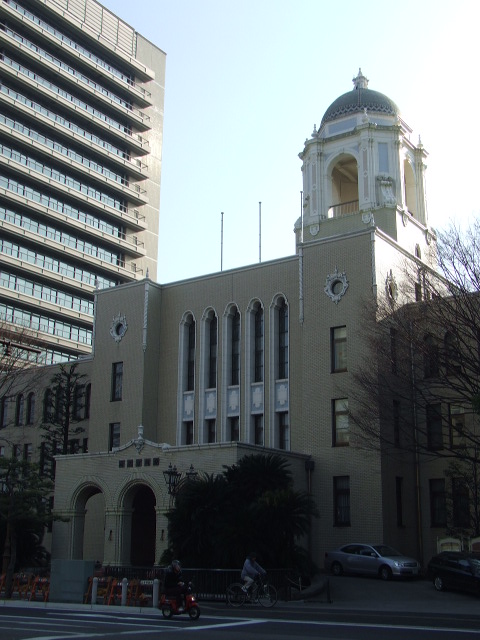|
Shizuhatagayama Kofun
270px, exterior is a dome-shaped ''kofun'' burial mound located within the grounds of the Shizuoka Sengen Shrine complex in Aoi-ku, Shizuoka, Japan. in the Tōkai region of Japan. The site was designated a National Historic Site of Japan in 1953. Overview The Shizuhatayama Kofun is located on a 50-meter hilltop immediately behind the ''Honden'' of the Ohtoshimioya Shrine within the Shizuoka Sengen Jinja complex. Its existence has been known since ancient times and Edo period documents indicate that the burial chamber was exposed after a tree fell in a storm during the Tenmei or Bunsei era. The first modern archaeological excavations were conducted in 1949 and 1955, at which time the structure of tumulus was found to consist of a stone dome, approximately 32 meters in diameter and seven meters in height. There was no evidence of ''fukiishi'' or ''haniwa''. Within is a horizontal chamber of cut stones with a length of 6.5 meters, height of 2.3 meters and width of 1.8 meters. A rock ... [...More Info...] [...Related Items...] OR: [Wikipedia] [Google] [Baidu] |
Aoi-ku, Shizuoka
is one of three wards of the city of Shizuoka in Shizuoka Prefecture, Japan, located in the northern part of the city. Aoi-ku borders Suruga-ku in the south and Shimizu-ku to the southeast; the west faces Shimada, Fujieda and Kawanehon and its northern tip extends into the border between Nagano Prefecture and Yamanashi Prefecture. It is the largest ward in Japan in terms of geographic area. Aoi-ku was created on April 1, 2003, when Shizuoka became a city designated by government ordinance (a "designated city"). It consists of the area of Shizuoka prior to its merger with Shimizu, north of the Tōkaidō Main Line rail tracks. The ward is home to both the Shizuoka city offices as well as the Shizuoka prefectural offices. Geography Climate Aoi-ku has a climate characterized by hot and humid summers, and relatively mild winters (Köppen climate classification ''Cfa''). The average annual temperature in Aoi-ku is . The average annual rainfall is with September as the we ... [...More Info...] [...Related Items...] OR: [Wikipedia] [Google] [Baidu] |
Archaeological Excavation
In archaeology, excavation is the exposure, processing and recording of archaeological remains. An excavation site or "dig" is the area being studied. These locations range from one to several areas at a time during a project and can be conducted over a few weeks to several years. Excavation involves the recovery of several types of data from a site. This data includes artifacts (portable objects made or modified by humans), features (non-portable modifications to the site itself such as post molds, burials, and hearths), ecofacts (evidence of human activity through organic remains such as animal bones, pollen, or charcoal), and archaeological context (relationships among the other types of data).Kelly&Thomas (2011). ''Archaeology: down to earth'' (4th ed.). Belmont, Calif.: Wadsworth, Cengage Learning. Before excavating, the presence or absence of archaeological remains can often be suggested by, non-intrusive remote sensing, such as ground-penetrating radar. Basic informat ... [...More Info...] [...Related Items...] OR: [Wikipedia] [Google] [Baidu] |
Tourist Attractions In Shizuoka Prefecture
Tourism is travel for pleasure or business; also the theory and practice of touring, the business of attracting, accommodating, and entertaining tourists, and the business of operating tours. The World Tourism Organization defines tourism more generally, in terms which go "beyond the common perception of tourism as being limited to holiday activity only", as people "travelling to and staying in places outside their usual environment for not more than one consecutive year for leisure and not less than 24 hours, business and other purposes". Tourism can be domestic (within the traveller's own country) or international, and international tourism has both incoming and outgoing implications on a country's balance of payments. Tourism numbers declined as a result of a strong economic slowdown (the late-2000s recession) between the second half of 2008 and the end of 2009, and in consequence of the outbreak of the 2009 H1N1 influenza virus, but slowly recovered until the COVID-19 pa ... [...More Info...] [...Related Items...] OR: [Wikipedia] [Google] [Baidu] |
Kofun
are megalithic tombs or tumuli in Northeast Asia. ''Kofun'' were mainly constructed in the Japanese archipelago between the middle of the 3rd century to the early 7th century CE.岡田裕之「前方後円墳」『日本古代史大辞典』大和書房、2006年。 The term is the origin of the name of the Kofun period, which indicates the middle 3rd century to early–middle 6th century. Many ''kofun'' have distinctive keyhole-shaped mounds (). The Mozu- Furuichi kofungun or tumulus clusters were inscribed on the UNESCO World Heritage List in 2019, while Ishibutai Kofun is one of a number in Asuka-Fujiwara residing on the Tentative List. Overview The ''kofun tumuli'' have assumed various shapes throughout history. The most common type of ''kofun'' is known as a , which is shaped like a keyhole, having one square end and one circular end, when viewed from above. There are also circular-type (), "two conjoined rectangles" typed (), and square-type () kofun. Orientation ... [...More Info...] [...Related Items...] OR: [Wikipedia] [Google] [Baidu] |



